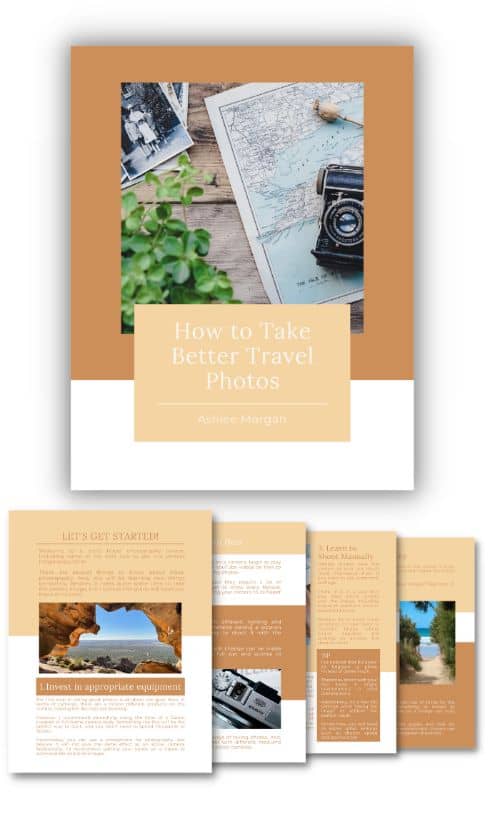Hiking the outdoors is one of the best ways to get outside and appreciate all that nature has on offer. Moreover, it’s even better enjoyed with friends or in a hiking group.
Planning a single day or multi-day hike is one of the most exciting parts of the journey. Although, there are a few things to keep in mind before jumping on the trails.
The organisation of a hiking trip is crucial, and going deep into bushland requires serious attention. Therefore, use the packing advice, safety tips and hiking checklist to ensure your outdoor excursion is the best it can be.
Finally, most of the tips and information shared in this post is from my personal experience throughout the past few years of hiking. However, I’ve made many mistakes along the way; I hope this encourages a beginner to get out into nature with confidence. Also, don’t forget to create your own hiking checklist including your favourite items to take.
Disclaimer: Some of the links in this post are affiliate links. This means that I may earn a small commission on purchases made through these links at no extra cost to you. You can read my full affiliate disclosure here.
Hiking in Australia
There is an immeasurable array of mountainous landscapes, rugged cliff lines and mysterious woodlands to explore by foot in Australia. Thankfully, hiking in Australia is quite a doable task for many individuals, no matter their fitness level.
However, it’s still important to stay vigilant on the trails and stay aware of the potential dangers of the Australian landscape.
Not to scare you, but tens of thousands of people go missing in the Australian bush every year. With that being said, take the following advice seriously to ensure your safety at all times.

Hiking Safety
Before we get into the fun stuff, let’s start on the basics of hiking safety. Hiking is an extremely, physically-demanding venture, and some individuals may not be aware of the lack of their physical capabilities. In fact, something as simple as a sprained ankle could wind you up in a lot of trouble.
- Check the nature of the weather in the region you’re hiking: Oftentimes, there is a chance that the weather may read as a 28°C warm day within the city and suburbs, but deep within the forest woodlands, the temperature may drop to around 14°C. Do not hike before, during or after a storm, heavy rain or strong winds.
- Stay on the trail and follow all of the signage: Never leave the track, as getting lost in the bushland is easier than you may think.
- Avoid going further than what you can handle: If fatigue sets in and you have the option to turn around, it may be best to do so. Don’t push yourself further than your limit, as this is when accidents happen, and trouble begins.
- Mobile phone service: It’s very likely you’ll lose phone service at some point within your hike, even when reasonably close to main cities. Also, use a physical map where possible or take phone screenshots of the path you plan to walk along. I like to use the app ‘Alltrails’ for offline maps.
- Avoid hiking alone: This is an important factor on hiking safety and can lead to all kinds of situations; If you injure yourself along the trail and don’t have mobile service, this may wind you up in a bit of trouble. Moreover, encourage a friend or family member to join your trek and let someone else know where you’re going.
- Build up your walking stamina: Don’t jump straight into a 15km hike if you can’t currently walk that distance. Furthermore, be realistic about your fitness level and start slow; There’s always room for growth!
- Pack plenty of water and snacks for a day hike: On average, you will need about half a litre of water per hour of exercise. Also, be reasonable about your snacks and pack high-energy based food.
- Research the track and check with official sites before hiking: There’s nothing worse than arriving to your starting location, only to discover a closure of the trail. Be prepared and look online before visiting.
- Tell a trusted family member or friend where you’re going: Before each hike, tell someone where you intend to hike and the trail(s) you’ll be walking along, don’t forget to get in writing (sending a text message is a good idea). Also, let them know what time you will be returning. In case of an emergency, if this person hasn’t heard back from you after the time you should’ve returned, they can raise alarm to nearby emergency services.
Hiking Checklist
There are several things you could bring on your next hiking adventure. Although, it’s essential to pick these wisely as you don’t want to be carrying the unnecessary weight of things you don’t need.
Continue reading the hiking checklist on some of the best items to bring:
- Navigation / Offline maps: Save weight on your hiking daypack and download offline maps onto your mobile device. These are important for staying on track and keeping aware of the distance you’ve travelled.
- Battery pack: Avoid running out of battery with a lightweight battery pack. Therefore, this will ensure you get back to your destination safely. Although this likely isn’t necessary for shorter hikes, I’d recommend adding this to your pack for adventures over 3 hours.
- Lightweight rain jacket and hooded jacket: Keep dry and warm with these clothing items. Upon reaching the peak of a mountain, it’s usually very windy and often cold, resulting in body temperature dropping quickly!
- Lots of water and an adequate amount of snacks: There’s no need to overpack on food and drink, but a substantial amount is ideal.
- Quality footwear: Ensure your footwear has optimal tread and ankle support. Hence the reason why hiking boots are popular. However, if you’d prefer to wear trail runners, they will likely be okay.
- A comfortable backpack: An ergonomic, comfortable and lightweight backpack is essential for housing all of the items you take.
- Travel-sized bug spray and sunscreen: There’s nothing worse than getting far into your hike only to be bothered by mosquitoes and other insects. Avoid this disaster by taking bug spray. Also, we all know that the Australian sun is extremely harsh; Be sure to wear sunscreen on days where the UV rating is above 3.
- First-aid kit: Grab a travel-sized first-aid kit in case of any accidents along the trail.
- Sun protection such as a hat or sunglasses: Reduce glare and heighten your vision with sunglasses or a hat. Moreover, these are also vital for sun protection.
- Headlamp: Bring a headlamp incase you are hiking before sunrise, or you plan to walk through unlit areas such as dark bushlands. Avoid taking a hand-held torch or lighting equipment as it’s much more convenient to have your hands prepared in case of a fall or the need to climb rocks.
In addition, if you are completing a multi-day hike you will need to include more food and water, a change of clothes and lightweight camping gear.
Read more: Travel Advice in Australia: 10 Things You Should Know
Hiking Tips
A handful of practical tips to make use of on your next trek.
- While hiking during hot weather, fill your water canister halfway and freeze the night before the hike. Then, fill the rest of the bottle with regular water before starting the hike; This will result in icy cold water for the majority of the event.
- Research the trail before visiting and familiarise yourself with the surroundings. Also, it’s a great idea to look for reviews online; This will ensure your preparation for the journey.
- Get involved in hiking community groups on social media; This is a fun way to meet people and discover less popular trails.
- Take small (recycled) plastic bags with you to keep your rubbish and food scraps in one place. There is nothing worse than a banana peel flopping about in your daypack and creating a mess.
Hiking Daypack
Currently, there are tonnes of options for hiking backpacks available on the market. From daypacks to overnight packs, there’s something for each body type and specific needs.
When purchasing a hiking daypack, be sure to wear it for at least 10 minutes and add some weight to it to get an idea of how it feels.
Additionally, if hiking is something you plan to take seriously, consider investing in a quality pack. Moreover, this will ensure that it doesn’t fail you on your expeditions, is comfortable to wear for extended periods and will last many years.
Furthermore, listed below are a few options for some daypacks I would recommend. Be sure to add a quality daypack to your hiking checklist.

Buy the Osprey Talon 22 from Amazon

Buy the Kelty Coyote Travel Backpack from Amazon

Buy the Loowoko Hiking Backpack from Amazon
Hiking Food Ideas
One of the most significant parts of your hiking checklist is the food you plan to bring with you. Moreover, pack nutritious snacks for boosts of energy to assist your journey.
Some of the best hiking food ideas come from experimentation and experience on the tracks. For example, it’s not unusual to be caught with random food combinations which end up a favourite.
However, I have personally tried and tested some of these hiking food ideas, so I present to you some of the best things to bring along your trek:
- Nuts and seeds are packed with protein and energy
- Muesli bars, energy bars and protein bars
- Dried crackers and biscuits (If you’re feeling fancy and going on a short hike, take some dipping sauce)
- Fruit
- Salad sandwiches and rolls
- Instant mashed potatoes
- Dehydrated food (Best for multi-day hikes)
- Tuna and Salmon
- Electrolyte power
- Hard-boiled eggs
- Carrots (Great to enjoy with hummus)
Wrapping up the Hiking Checklist
In conclusion, hiking is a fantastic physical activity which people of all ages and fitness abilities can enjoy. Of course, hiking is ideal with company but is still an enjoyable experience solo.
Also, it is known by many professional hikers around the world to take preparation cautiously and stay vigilant while out in nature. Many things can go wrong, although the information above includes some practical ways to warrant safety.
Finally, be sure to check official websites for more information on trail closure and local dangers; It pays to be prepared.
Where are you planning your next hiking adventure? Have you discovered something new within this post that will assist your next journey?
Read more: Tarra-Bulga National Park: Travel Guide
Read more: The Top 5 Dandenong Ranges Walks












